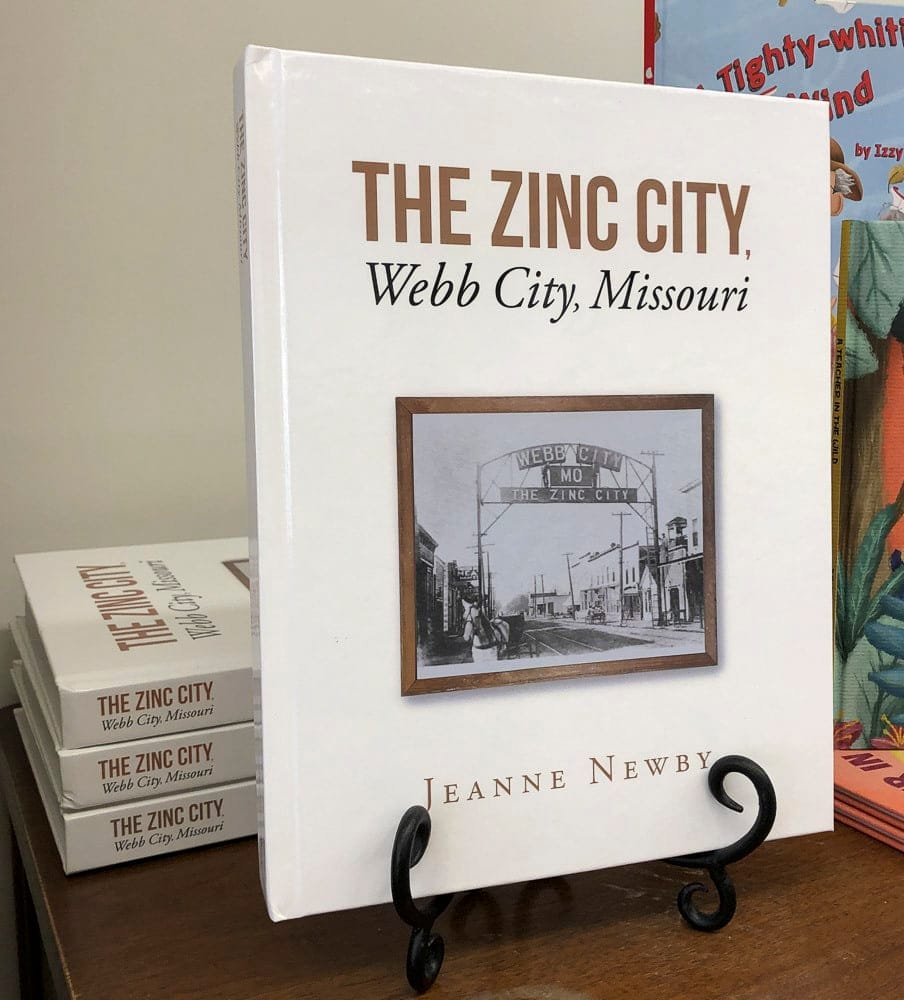
Downtown Webb City, looking north, with the current Twisted Oak building on the left.
Webb City became an incorporated city in 1876. A fairy tale come true as the city constantly grew and the mining industry sky rocketed. As the city prospered, it was obvious that Webb City was going to be a wealthy town destined for greatness.
In 1891, The Commercial Club was organized to help strengthen this growing community. There were 140 members who joined together to bring new business and industry to Webb City.
By the time the city reached its 40th year in 1916 – The Mining Industry reached an all-time high. Zinc was valued at $135 a ton coming up from $84 a ton. More than 50 mines were located around Webb City and were in operation. The population of Webb City had reached 18,000.
Webb City was known as the Richest Zinc and Lead Mining District in the World. Some of the signs of progress in the city included:
Two phone companies, Bell Telephone Co. and Home Telephone Co., which made life hectic for the businesses that had to have a phone from each company to allow customers of both companies to call them.
Two newspapers, The Webb City Sentinel Daily Paper and the Webb City Register.
Good utilities, and streets were being bricked.
Impressive buildings were being added to the assets of the city.
A Carnegie library, completed Dec. 31 at a cost of $25,000.
The new Frisco Depot at Madison and Daugherty streets. It had previously been on Fourth Street.
A new federal building (post office), built at a cost of $90.000 on Daugherty Street.
Many new business buildings.
An impressive new high school on Broadway street.
Beautiful homes were built all over the city.
Completion of the Jefferson Highway brought travelers into town. The highway entered Webb City on East Daugherty to Devon, across to Broadway, west to Main Street. South on Main to Fourth, west on Fourth to Madison, south to what would be the new concrete road, which began at 13th and Madison. The concrete highway extended through Royal Heights to Broadway in Joplin. The concrete road was built by the Works Progress Administration.
Yes, the 40th birthday of the city showed lots of prosperity. Then it happened…
The greatest ore strike in the Tri-State district was discovered in Oklahoma in 1918.
It was the beginning of the end for Webb City’s mines. The miners, themselves were excited about the new strike because in Oklahoma, the miners did not have to deal with the “Devil Water” like we had here in our district. Devil water could shut down a mine and put miners out of work for days or longer. Miners dropped what they were doing, jumped on the streetcar and headed to Oklahoma. Mines were left with machinery still in place, ore waiting to be mined and mine owners without workers.
Some city leaders might have been worried about their own futures without the mining industry, but the majority of them thought of the city first. They knew they could not to allow the city to die. As the miners left, the Commercial Club, which had been reorganized the year before in 1917 as the Chamber of Commerce, started the campaign to find industry for Webb City. If they couldn’t be a mining town then they would industrialize.
Preble Shoe Mfg. Co. was established and began making high grade children’ shoes.
Elder Garment Plant (the shirt factory) opened. Chamber members raised $20,000 to purchase the lot and build the building to bring Elder’s to town.
Within two years, by 1920 – Webb City attained the distinction of increasing her industries more than any other city in the United States, with an increase of 250 percent.
Webb City had added… the shoe factory, and shirt factory as I have already mentioned. Also a leather factory, tobacco (cigar) factory, and a box factory were established. The chamber stepped in and assisted existing industries in obtaining and increasing business, including the Interurban Ice Co., Jersey Ice Cream and Butter Factory, The Star Bottling Works, Ball & Gunning Co., West Side Machine Shop, Webb City and Carterville Foundry and Machine Co., Rex Casket Co., Independent Gravel Co., Crocker Packing Co..
Webb City adopted the motto, “Get Down and Come In,” a real invitation to the manufacturers and farmers, in the business way, as well as to strangers in the hospitable way. Webb City was coming into her own, by the faith of the people and by the initiative of her businessmen, the Chamber of Commerce.
In 1922, the students of Webb City High School dedicated the King Jack Annual to the Webb City Chamber of Commerce with this statement.
To that alert and progressive organization of citizens who, with high ideals and unremitting labor, have successfully striven for the betterment of our community, with deepest appreciation of their kind services – The Webb City Chamber of Commerce – this volume of King Jack is respectfully dedicated.
The Chamber of Commerce saved Webb City from becoming one of the many “ghost town” mining camps that were scattered around the area. We owe a lot to our Chamber of Commerce and they have continued for over 100 years to help our city and area to prosper.

Jeanne’s new book, “The Zinc City, Webb City, Missouri” is now available at Webb City Chamber Office.
